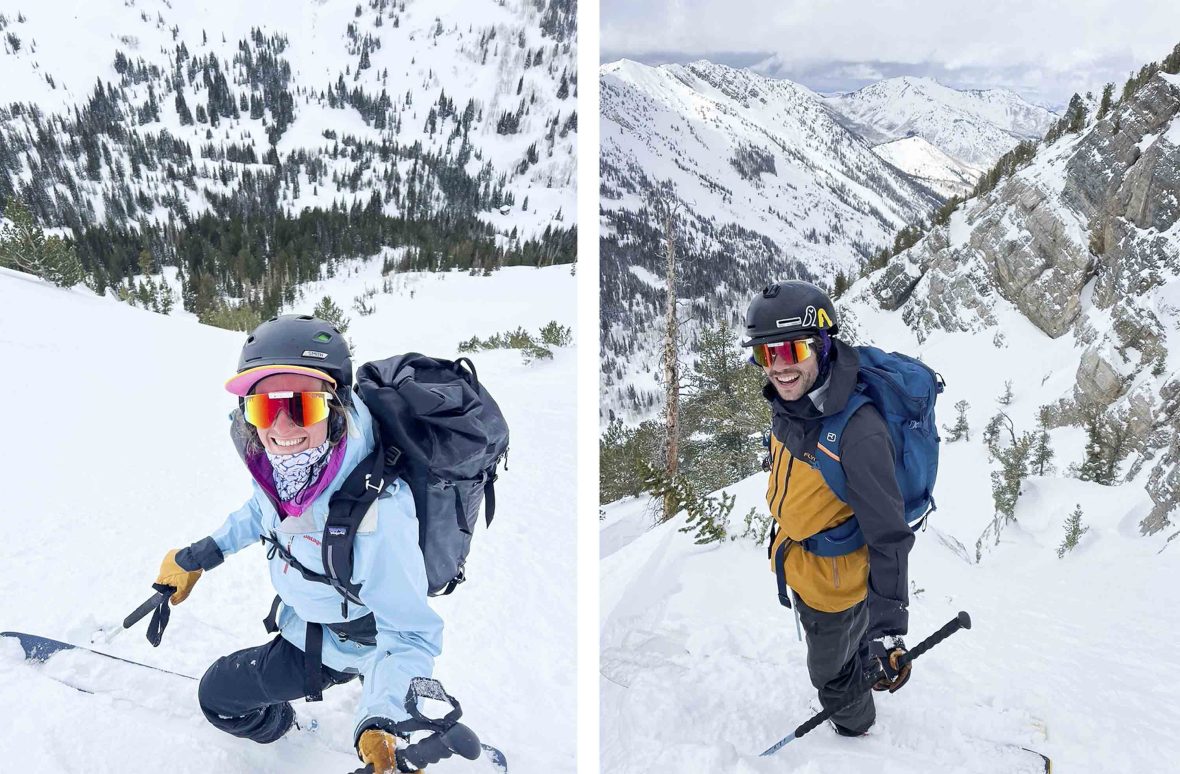
Climate change is transforming the mountains as we know them. What does that mean for the future of alpine activities, and the planet? Researchers Anneka Williams and Jack Stauss take a closer look.


Climate change is transforming the mountains as we know them. What does that mean for the future of alpine activities, and the planet? Researchers Anneka Williams and Jack Stauss take a closer look.
We escape the bustle of Salt Lake City, parking at the Neff’s Canyon trailhead. After a few minutes spent buckling up boots and adjusting layers to get just the right amount of warmth, we take off into the Central Wasatch’s towering snow-covered peaks on our backcountry skis. As we ascend, a dense thicket of oak gives way to aspen glades, which widen to old fir and stubby, twisted limber pine.
After two hours of climbing, we reach a large meadow and pause. A crown-shaped cirque of jagged quartzite teeth cuts into the sky around us. Snowy chutes line the cirque’s interior. They are straight, narrow, and steep. We hope to ski one of these couloirs today if the conditions allow.
Those of us who backcountry ski walk a careful line between risk and reward as we navigate different weather and snow conditions every time we venture out. Success is an alchemy of planning, good timing, stable conditions, an intimate knowledge of the terrain and an expert level of execution. Over the last few decades, this alchemy has only become more complex as snowfall becomes less predictable and temperatures fall outside of historic ranges.
Climate change is impacting our alpine environments and snowpacks in unprecedented ways. While we are in places like Neff’s Canyon, we are inextricably part of this shift. Here, we see change on a scale that is hard to grasp from the front country. Once-familiar terrain is becoming unrecognizable and hazards are increasing. Out here, it feels like we are meeting climate change head-on.

In the Western United States, several winters of strange weather have resulted in unfortunate, and often deadly, avalanche conditions. These conditions arise from warming temperatures, shifting storm cycles and a less stable snowpack. And these trends are not confined to the American West.
In our state of climate precarity, the mountains are keeping score and it is not looking good. Last summer, glacial collapses in Italy and Kyrgyzstan raised the alarm about the impact of warming temperatures, which have risen, on average, two degrees Fahrenheit since 1880. However, certain mountainous regions are more vulnerable to climate warming. The European Alps, for example, are warming twice as fast per decade compared to rates of global surface warming. In the Mont Blanc region, authorities warned alpinists of the imminent dangers of climate change in mountain environments during the climbing season of 2022. Name a mountainous country, and there will likely be an example of climate-related ice and snow changes.
Stopping in the Upper Neff’s Canyon meadow to gaze at the couloirs above us is both exciting and a bit scary. We have to focus. Each step takes on a new gravity as we leave the meadow and climb higher. We notice wispy snow being carried by the wind and feel for density changes in the snowpack. At first, it looks good. The snow is easy to walk through. We continue, stopping only to strap our skis to our backs as we begin to bootpack up the steep couloir.
Observing the environments through which we move has always been a hallmark of backcountry skiing. We track weather and snowpack over seasons to build a full story of the places we explore. In doing so, we are forced to feel how changing snowpacks change communities in a rapidly warming world.

Baker Perry, Professor of Geography at Appalachian State University and a National Geographic Explorer, has long been on the front lines of climate change in alpine environments. Perry studies weather and climate in some of the world’s highest mountain ranges and has collected data on snowpack changes and the impact those changes have on people and communities right now. Alpine environments rely on the seasonal accumulation and melt of snowpacks to provide water to surrounding communities. Climate change has created a scenario in which snowpacks are less stable and no longer reload soil, rivers, lakes and reservoirs with a consistent water supply. Furthermore, warmer temperatures can create more extreme melt and runoff events, which lead to heavy erosion and flooding.
“Everything that has been the standard of my relationship to the snowpack doesn’t account for what’s happening today.”
- Connor Ryan
“One of the biggest changes we’re seeing in high mountains is that the freezing line [the altitude where rain turns to snow] is rising and has risen substantially just in the past 20 years,” Perry explains. “And that has a huge impact on the phase of precipitation, whether it’s falling as snow or rain or a mix. What’s really needed to sustain snowpack is consistently low temperatures. What we see is this increase in thaws and warm days coming in. Those cycles make it very difficult to build and to sustain snowpack.”
The proportion of precipitation that falls as rain versus snow impacts both the total amount of snow and ice on mountains. It also impacts the stability of the snowpack for backcountry travelers. Brian McInerney, the now-retired senior hydrologist and climate scientist for the National Weather Service in Salt Lake City, describes a two-part climate change-induced feedback loop that creates bigger, scarier and more unpredictable avalanches.
Since the Arctic has warmed much more rapidly than the equator, the very fast upper-level winds of the polar jetstream have slowed and become more sinuous, forcing weather and storms to the north. “In places like the Western United States that have traditionally had consistent storm cycles, there are now longer periods of high pressure and dry weather,” explains McInerney. “During these dry spells, snow on the ground changes: crystals morph in shape and lose their ability to bond to one another.” This creates a “persistent weak layer” on which avalanches can slide.
The second part of the equation is that as temperatures rise, the atmosphere is able to hold more moisture. “So, when storms do come after prolonged periods of high pressure, they are warmer and wetter,” says McInerney. These weather events often hit the Intermountain West ‘upside-down,’ meaning heavier snow is overlaying the pre-existing persistent weak layer. This creates a set-up for big slab avalanches, which can be triggered naturally from heavy storm loading or from an unsuspecting skier that steps on the slab in the wrong spot.
Since 2021, there have been multiple tragic, historic avalanche accidents both in the American West and internationally. In many of these accidents, the avalanche was the result of the conditions described above—a radical storm event dropping new snow on an old persistent weak layer.
Back in Neff’s, we punch our boots into the soft wind-textured surface. The top layers of the snowpack start to feel different as we ascend higher. We dig our hands down into the layers and cut out a small block, finding a solid slab of wind-battered snow sitting atop looser, weak snow. It’s the perfect set-up for an avalanche. We look at each other knowing that the snowpack beneath us has the potential to shatter like a pane of glass and carry us down with it.
Changing environments means changing our behavior. In a high altitude, cold environment like the Colorado Rockies, Lakota skier and filmmaker Connor Ryan is observing temperatures that are, at times, 20-30 degrees Fahrenheit warmer than average.
“Everything that has been the standard of my relationship to the snowpack doesn’t account for what’s happening today,” explains Ryan. “The fact that this can happen in a variety of ways in different places is what stands out to me as the thing that’s so odd.”
Ellen Bradley, Lingít skier and scientist, also finds this unpredictability disconcerting: “It’s hard to trust backcountry skiing when the conditions are becoming more variable, so I think we’re going to have to reframe our mindsets around what skiing is and why we do it.”
The new mission is to pay closer attention to the natural world and use the proximity to climate change skiing offers to become more informed climate advocates.
As trends in winter conditions change, there simply won’t be the snowpack or stability to support the same routes and lines that skiers and alpinists have targeted in previous decades. Objectives and perspectives will have to be modified. But the impact extends beyond just skiing. Changes in alpine environments are a striking bellwether for the changes in climate that are affecting every topography, every activity and every ecosystem. Skiing is just one case study of how, in our own ways, we all will need to change how we engage with different landscapes.
Heatwaves, wildfires, drought, and sea level rise are just some examples of how climate change will impact different geographies across the world. From rethinking where we build our homes to where we choose to travel, to what activities we do in each season, we’re all going to have to adapt our behavior to these changes in some way.
Bradley and Ryan have both already begun to reframe their relationship with skiing in the context of a changing climate. For them, this means leaning into the relationship skiing helps them build with the land. It’s no longer just about getting extreme, seeking powder and tackling big lines. It’s about supporting younger skiers, paying closer attention to the natural world and using the proximity to climate change skiing offers to become more informed climate advocates.
“We need to think about what it is that we really celebrate in skiing,” Ryan says. “Not what we’re taught to idolize through ski films, but the smaller things that haven’t necessarily been celebrated in ski movies and media.”
Though all alpine activities are threatened by shifting climate patterns, they are also a medium through which we can develop a stronger understanding of the environment and the impacts we have on our future. “[Skiing in the backcountry] makes you aware of your role as an active participant in your environment, the snowpack, and the watershed. It’s a great access point for people to be in the position of seeing how places change year to year, month to month, and storm to storm,” explains Ryan.

We trace our boot pack steps back down to safer ground, click back into our ski bindings and pivot on our track, turning away from the couloir we’d hoped to ski in favor of less avalanche-prone terrain to the north. We ascend through a dense stand of trees in silence, reflecting on the conditions we just encountered. The decision to alter plans is perhaps a harbinger of winters to come as we navigate rapidly changing mountain environments and the terrain we thought we once knew becomes less familiar.
Why do we ski? Is it for bold mountain pursuits and technical ski lines? Perhaps. But it’s also to listen to the mountains and recognize the joy that comes from the simple act of gliding through an open meadow or sun-dappled aspen glade or enjoying a moment of quiet on an alpine ridge. For us, it’s about connecting to places and natural cycles, storm after storm, winter after winter.
As our winters change and the landscape of risk in alpine zones shifts, skiers and alpinists will likely need to reframe their relationship to alpine activities. But the changes also demand that we reframe our relationship to the world—and our role as stewards of it. The act of getting out in the backcountry requires us to be more attuned to the environmental conditions of our time. In this way, it offers us a front-row seat to a leading climate change indicator. It demands that we pay attention, take responsibility and take action. It’s an important mindset for these long days in the mountains; and, as we’re learning, for our daily lives.

Anneka Williams is a climate scientist and writer. Her research explores how climate change is impacting high-latitude and high-altitude ecosystems and communities.
Jack Stauss is a skier and writer who works with the non-profit Glen Canyon Institute in Utah, focusing on public lands and environmental protection.






Can't find what you're looking for? Try using these tags: